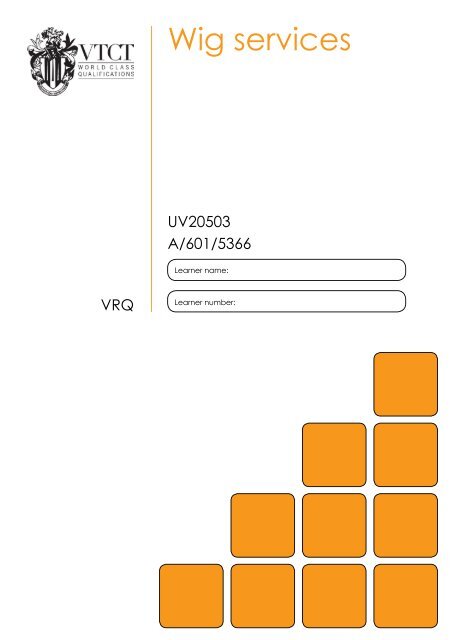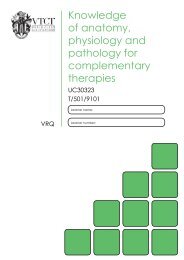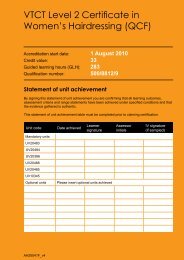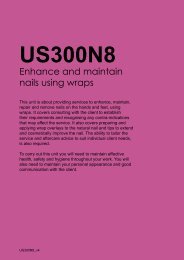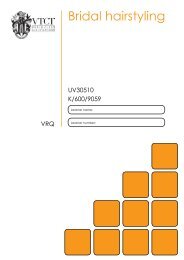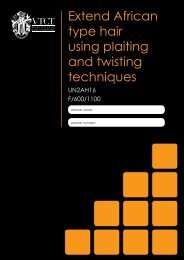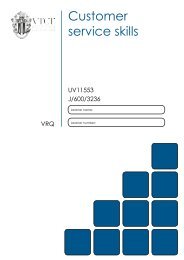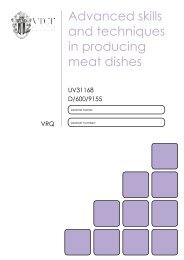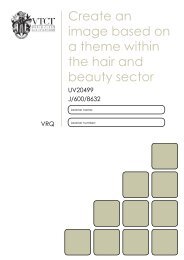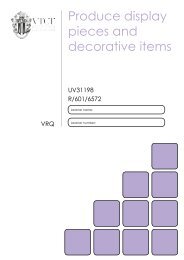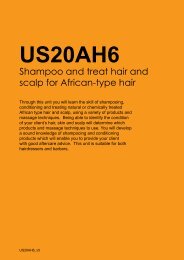Create successful ePaper yourself
Turn your PDF publications into a flip-book with our unique Google optimized e-Paper software.
VRQ<br />
Wig services<br />
<strong>UV20503</strong><br />
A/601/5366<br />
Learner name:<br />
Learner number:
Statement of unit achievement<br />
<strong>VTCT</strong> is the specialist awarding body for the Hairdressing, Beauty Therapy,<br />
Complementary Therapy and Sport and Active Leisure sectors, with over 45<br />
years of experience.<br />
<strong>VTCT</strong> is an awarding body regulated by national organisations including<br />
Ofqual, SQA, DCELLS and CCEA.<br />
<strong>VTCT</strong> is a registered charity investing in education and skills but also giving to<br />
good causes in the area of facial disfigurement.<br />
By signing this statement of unit achievement you are confirming that all learning outcomes, assessment<br />
criteria and range statements have been achieved under specified conditions and that the evidence<br />
gathered is authentic.<br />
This statement of unit achievement table must be completed prior to claiming certification.<br />
Unit code Date achieved Learner signature<br />
Assessor tracking table<br />
Assessor name Assessor signature<br />
Assessor<br />
initials<br />
Assessors<br />
initials<br />
IV signature<br />
(if sampled)<br />
All assessors using this Record of Assessment book must complete this table. This is required for<br />
verification purposes.<br />
Assessor number<br />
(optional)
<strong>UV20503</strong><br />
Wig services<br />
Through this unit you will develop the skill of preparing and<br />
fitting various types of wigs and hair pieces for your clients.<br />
You will develop the skill of creating a comfortable<br />
setting for your clients, and provide them with a thorough<br />
consultation. You will fit, adjust, cut, style and maintain wigs<br />
and hairpieces using a variety of tools and techniques.<br />
Part of this service is to provide your client with good<br />
aftercare advice.<br />
This unit is suitable for both hairdressers and barbers.<br />
<strong>UV20503</strong>_v6
Level<br />
Credit value<br />
GLH<br />
2<br />
5<br />
40<br />
Observation(s)<br />
3<br />
External paper(s)<br />
1
Wig services<br />
Learning outcomes Evidence requirements<br />
On completion of this unit you will:<br />
1. Be able to prepare and fit different types of<br />
wigs<br />
2. Be able to cut and style wigs<br />
1. Environment<br />
Evidence for this unit must be gathered in a<br />
real or realistic working environment.<br />
2. Simulation<br />
At least 75% of ‘Observation’ outcomes<br />
must be on real clients.<br />
3. Observation outcomes<br />
Competent performance of ‘Observation’<br />
outcomes must be demonstrated to your<br />
assessor on at least three occasions.<br />
4. Range<br />
All ranges must be practically demonstrated<br />
or other forms of evidence produced to<br />
show they have been covered.<br />
5. Knowledge outcomes<br />
There must be evidence that you possess<br />
all the knowledge and understanding<br />
listed in the ‘Knowledge’ section of this<br />
unit. This evidence may include projects,<br />
assignments, case studies, reflective<br />
accounts, oral/written questioning and/or<br />
other forms of evidence.<br />
6. Tutor/Assessor guidance<br />
You will be guided by your tutor/assessor<br />
on how to achieve learning outcomes and<br />
ranges in this unit. All outcomes and ranges<br />
must be achieved.<br />
7. External paper<br />
Knowledge and understanding in this unit<br />
will be assessed by an external paper.<br />
The criteria that make up this paper are<br />
highlighted in white throughout this unit.<br />
There is one external paper that must be<br />
achieved.<br />
<strong>UV20503</strong><br />
3
4<br />
Achieving observations<br />
and range<br />
Achieving observation outcomes<br />
Your assessor will observe your performance<br />
of practical tasks. The minimum number<br />
of observations required is indicated in the<br />
evidence requirements section of this unit.<br />
Criteria may not always naturally occur during<br />
a practical observation. In such instances you<br />
will be asked questions to demonstrate your<br />
competence in this area. Your assessor will<br />
document the criteria that have been achieved<br />
through oral questioning.<br />
Your assessor will sign off an outcome when all<br />
criteria have been competently achieved in a<br />
single client service.<br />
Achieving range<br />
The range section indicates what must<br />
be covered. Ranges should be practically<br />
demonstrated as part of an observation. Where<br />
this is not possible other forms of evidence may<br />
be produced. All ranges must be covered.<br />
Your assessor will document the portfolio<br />
reference once a range has been competently<br />
achieved.<br />
<strong>UV20503</strong><br />
Maximum service times<br />
There are no maximum service times that apply<br />
to this unit.
Outcome 1<br />
You can:<br />
a. Create the right setting in which clients feel<br />
comfortable enough to express their needs,<br />
expectations and concerns<br />
Observations<br />
Be able to prepare and fit different types of wigs<br />
b. Prepare yourself, the client, the wig/<br />
hairpieces and the work area for the service<br />
c. Use suitable consultation techniques that<br />
enable the client to express their concerns<br />
and expectations without embarrassment<br />
d. Fit and adjust wigs/hairpieces on the client’s<br />
head<br />
e. Complete client records including head<br />
measurements/sizes<br />
f. Follow safe and hygienic working practices<br />
*May be assessed through oral questioning.<br />
Observation 1 2 3<br />
Date achieved<br />
Criteria questioned orally<br />
Portfolio reference<br />
Assessor initials<br />
Learner signature<br />
<strong>UV20503</strong> 5
6<br />
© Habia<br />
Outcome 2<br />
Be able to cut and style wigs<br />
You can:<br />
a. Select and use products, tools, equipment<br />
and techniques as required to achieve the<br />
desired look<br />
b. Cut and style wigs to achieve a<br />
personalised look<br />
c. Monitor and maintain client comfort<br />
throughout the service<br />
d. Complete the service to the satisfaction of<br />
the client<br />
*May be assessed through oral questioning.<br />
Observation<br />
Date achieved<br />
Criteria questioned orally<br />
Portfolio reference<br />
Assessor initials<br />
Learner signature<br />
1 2 3<br />
<strong>UV20503</strong>
*You must practically demonstrate that you have:<br />
Range<br />
Considered all the influencing factors Portfolio reference<br />
Hair condition<br />
Hair cut<br />
Hair length<br />
Hair density<br />
Head and face shape<br />
Existing colour of hair<br />
Skin tone<br />
The occasion for which the style is required<br />
Used all cutting techniques Portfolio reference<br />
Club cutting<br />
Freehand<br />
Scissors-over-comb<br />
Used a minimum of 5 blow-drying and setting techniques Portfolio reference<br />
Straightening<br />
Smoothing<br />
Creating volume<br />
Creating movement<br />
Creating curl<br />
Directional set<br />
Brick set<br />
*It is strongly recommended that all range items are practically demonstrated. Where this is not<br />
possible, other forms of evidence may be produced to demonstrate competence.<br />
<strong>UV20503</strong> 7
8<br />
© Habia<br />
*You must practically demonstrate that you have:<br />
Used a minimum of 8 types of tools and equipment Portfolio reference<br />
Dressing comb<br />
Round brush<br />
Flat brush<br />
Pin curl clips<br />
Rollers and pins<br />
Heated rollers<br />
Tongs<br />
Straighteners<br />
Hand dryer<br />
Nozzle<br />
Hood drier<br />
Scissors<br />
Given all the types of aftercare advice Portfolio reference<br />
Suitable aftercare products and their use<br />
Use of heated styling equipment<br />
How to recreate and maintain the style<br />
Time interval between services<br />
*It is strongly recommended that all range items are practically demonstrated. Where this is not<br />
possible, other forms of evidence may be produced to demonstrate competence.<br />
<strong>UV20503</strong>
Achieving knowledge outcomes<br />
You will be guided by your tutor and assessor<br />
on the evidence that needs to be produced.<br />
Your knowledge and understanding will be<br />
assessed using the assessment methods listed<br />
below:<br />
• Observed work<br />
• Witness statements<br />
• Audio-visual media<br />
• Evidence of prior learning or attainment<br />
• Written questions<br />
• Oral questions<br />
• Assignments<br />
• Case studies<br />
Achieving the external paper<br />
Developing knowledge<br />
Where possible your assessor will integrate<br />
knowledge outcomes into practical observations<br />
through oral questioning.<br />
The external paper will test your knowledge of the criteria highlighted in white. A pass mark of<br />
70% must be achieved. Criteria not achieved will be identified to your tutor/assessor. You will then<br />
be orally questioned or asked to produce other forms of evidence as all unit criteria must<br />
be achieved.<br />
Your assessor will complete the following table when the 70% pass mark has been achieved.<br />
Paper Date achieved Assessor initials<br />
1 of 1<br />
<strong>UV20503</strong> 9
10<br />
Knowledge<br />
Outcome 1<br />
Be able to prepare and fit different types of wigs<br />
You can:<br />
g. Identify factors that may influence the selection of wigs/hairpieces<br />
h. Explain the importance of creating a setting in which clients feel<br />
comfortable and ensures privacy<br />
i. Explain the importance of treating clients with sensitivity and<br />
empathy<br />
j. Explain why it is important to encourage and allow time for clients<br />
to ask questions<br />
k. Explain how to check that clients understand verbal and written<br />
information that they have been given<br />
l. Explain the types of expectations, concerns and needs that the<br />
clients may have and how to deal with them<br />
m. Describe the factors that may influence the choice of services and<br />
resources<br />
n. State the importance of identifying factors that may limit, prevent or<br />
affect the service<br />
o. State the importance of recording all service details<br />
p. Explain the reasons for wearing wigs/hairpieces<br />
q. Describe how to cleanse and condition wigs/hairpieces<br />
*Assessor initials to be inserted if orally questioned.<br />
Requirements highlighted in white are assessed in the external paper.<br />
<strong>UV20503</strong><br />
Portfolio reference /<br />
Assessor initials*
Outcome 1 (continued)<br />
Be able to prepare and fit different types of wigs<br />
You can:<br />
r. Explain why there is a need to be sensitive when dealing with<br />
clients with hair loss<br />
s. Describe the growth cycle of hair<br />
t. Describe the salon’s requirement for client preparation, preparing<br />
yourself and the work area<br />
u. Outline safe and hygienic working practices<br />
*Assessor initials to be inserted if orally questioned.<br />
Requirements highlighted in white are assessed in the external paper.<br />
© Wahl<br />
Portfolio reference /<br />
Assessor initials*<br />
<strong>UV20503</strong> 11
12<br />
© Habia<br />
Outcome 2<br />
Be able to cut and style wigs<br />
You can:<br />
e. Explain the importance of choosing the correct products, tools,<br />
equipment and techniques to suit wigs/hairpieces and the client<br />
f. Describe the styling techniques that can be carried out for different<br />
types of wigs/hairpieces<br />
g. Explain the importance of personalising wigs<br />
h. Explain the importance of monitoring and maintaining client<br />
comfort throughout the service<br />
i. Describe the aftercare advice that should be provided to the client<br />
*Assessor initials to be inserted if orally questioned.<br />
Requirements highlighted in white are assessed in the external paper.<br />
<strong>UV20503</strong><br />
Portfolio reference /<br />
Assessor initials*
Unit content<br />
This section provides guidance on the recommended knowledge and skills required to enable you<br />
to achieve each of the learning outcomes in this unit. Your tutor/assessor will ensure you have the<br />
opportunity to cover all of the unit content.<br />
Outcome 1: Be able to prepare and fit different types of wigs<br />
Create a comfortable setting for your<br />
clients: Provide a degree of privacy<br />
(separate room, sectioned off area, away<br />
from salon windows, separate from other<br />
clients).<br />
Preparation of self: Clothes (salon<br />
requirements for uniform, clean/ironed<br />
clothes, non-restrictive, closed in low heel<br />
shoes), hair (clean, healthy, manageable,<br />
off face), personal hygiene (clean body,<br />
teeth, workable length clean nails,<br />
deodorant, no overpowering perfume/<br />
aftershave), personal protective equipment<br />
(gloves, apron, prevent dermatitis), minimal<br />
jewellery, positive attitude, ready to greet.<br />
Preparation of client: Remove client’s<br />
outer clothing, protect against damage,<br />
ensure client relaxed and comfortable<br />
(posture, aids service), remove excessive<br />
jewellery (avoid damage to jewellery and<br />
skin), gown, towel, plastic cape, barrier<br />
cream, ensure client comfort, record card.<br />
Preparation of work area: Chair,<br />
trolley, work station, equipment cleaned,<br />
appropriate sterilisation (barbicide,<br />
autoclave, UV, sterilising spray), complete<br />
destruction of all living organisms on tools<br />
and equipment, disinfection (remove<br />
contamination from hard surfaces, large<br />
work areas, floors and work surfaces, heat<br />
or chemical methods), use of trolley, safe<br />
professional presentation tools and<br />
equipment, visual check on large and small<br />
equipment, electrical equipment checked,<br />
portable appliance test, select height of<br />
chair/basin.<br />
Preparation of hair pieces:<br />
Human/animal hair – (to clean) ventilated<br />
room or use fume cabinet, cleaning fluid<br />
(trichloroethylene), decant in a bowl, turn<br />
wig inside out, place in bowl, allow fluid to<br />
penetrate hair, draw through fluid roots to<br />
points, continue until dust/dirt has been<br />
removed, remove from the fluid, place on<br />
towel, squeeze out excess moisture, hang<br />
by nape, allow fluid to evaporate, when<br />
completely dry fix to a malleable block and<br />
style.<br />
Artificial hair – (to clean) prepare bowl of<br />
warm soapy water, turn the postiche inside<br />
out, place wig in bowl, allow water to<br />
penetrate, squeeze gently to remove dirt,<br />
clean water and rinse, gently squeeze<br />
moisture out, allow to dry naturally, attach<br />
to a malleable block and brush as desired.<br />
Consultation techniques: Use a variety<br />
of methods to ensure suitability of service,<br />
product and technique.<br />
Questioning – open, closed, probing.<br />
Language – appropriate level for client,<br />
use of technical/non-technical language.<br />
Client expectations/needs – listen, clarify,<br />
advise, plan.<br />
History of hair – hair tests, touch, feel,<br />
look of hair.<br />
Advice – what will work, what will not?<br />
Use visual aids - shade charts, style book,<br />
portfolio, collection of pictures.<br />
<strong>UV20503</strong> 13
14<br />
© Habia<br />
Outcome 1: Be able to prepare and fit different types of wigs (continued)<br />
Factors that influence services:<br />
Previous chemical services, percentage of<br />
grey, client requirements, tools and<br />
equipment, presence of added hair,<br />
maintenance of style suitability.<br />
Hair condition – dry, greasy, normal,<br />
virgin, chemically treated, elasticity<br />
(strength of hair), porosity (damage to<br />
cuticle layer, the ability to absorb moisture).<br />
Hair cut/style – uniform layer, one length,<br />
short graduation, long graduation.<br />
Temperature – body heat, salon<br />
temperature, added heat.<br />
Texture – fine, medium, coarse.<br />
Length – short, medium, long.<br />
Density – fine, medium, thick.<br />
Growth patterns – cowlick, widow’s peak,<br />
nape whorl, double crown, male pattern<br />
baldness.<br />
Skin tone – fair, medium, olive, dark.<br />
Face shape – oval, round, square, oblong,<br />
heart, pear.<br />
Head shape – large, medium, small.<br />
Existing curl – tight, soft, wave.<br />
Lifestyle – job, family, financial, time.<br />
Test results - good, bad, caution, positive,<br />
negative.<br />
Type of wig – human or synthetic hair.<br />
Reason for hair loss – alopecia,<br />
chemotherapy, scar tissue.<br />
Hair and scalp contra-indications: Can<br />
prevent/alter service, product, technique.<br />
Type of conditions – skin disorders<br />
(disease, infestation, infection, defect,<br />
bacteria, virus, fungi, parasites).<br />
<strong>UV20503</strong><br />
Skin sensitivities – reaction.<br />
Allergies – latex, nut, plasters, perfume,<br />
oil.<br />
History of allergic reaction – positive<br />
reaction to skin test, colour service.<br />
Incompatible products – metallic salts,<br />
previous chemical treatments.<br />
Medication – prescription medication.<br />
Medical condition – high blood pressure,<br />
pregnancy, radio therapy, cancer.<br />
Hair condition – chemical, heat damage,<br />
environmental.<br />
Hair disorder – contagious/noncontagious.<br />
Skin disorder – contagious/<br />
non-contagious, cross infection (stylist to<br />
client, client to stylist).<br />
Contagious:<br />
Bacterial – impetigo (blisters, weep, yellow<br />
crust), folliculitis (yellow pustules), sycosis<br />
(yellow, spot, follicle), furunculosis (pus<br />
filled spot), sebaceous cyst (lump on top or<br />
under skin).<br />
Viral – warts (raised, rough skin, brown),<br />
herpes (blisters).<br />
Fungal – tinea capitis/ringworm (patches,<br />
pink/grey, scaly, broken hair).<br />
Animal parasites – pediculosis capitis<br />
(head lice, parasite, 6 legs, suck blood),<br />
scabies (parasites, mites).<br />
Non-contagious:<br />
Psoriasis – over production of skin cells,<br />
dry, silvery, scales.<br />
Cicatrical alopecia – scar.<br />
Alopecia totalis – complete hair loss.
Outcome 1: Be able to prepare and fit different types of wigs (continued)<br />
Male pattern baldness – hair recedes at<br />
hairline or loss crown.<br />
Traction alopecia – excessive pulling,<br />
brushing curling and straightening.<br />
Alopecia areata – stress, bald patches<br />
seborrhea (excessive oil).<br />
Dandruff – itchy, white, skin cells.<br />
Dry scalp – white, powdery.<br />
Eczema/dermatitis – allergic reaction to<br />
detergent, red, irritation, swollen, weeping.<br />
Acne – raised bumps and spots.<br />
Defects of the hair:<br />
Fragilitas crinium – spilt, dry, ends.<br />
Monilethrix – beaded hair.<br />
Trichorrhexis nodosa – rough, swollen,<br />
broken shaft.<br />
Sebaceous cyst – sebum filled lump.<br />
Damaged cuticle – dull hair.<br />
Fit and adjust wigs/hairpieces on the<br />
client’s head:<br />
Attaching a wig – hold the centre front,<br />
using finger and thumb, place on forehead<br />
hairline, gently ease the wig backwards,<br />
over the crown towards nape, ease<br />
protruding hair under wig using a tail comb,<br />
ensure that the fit is good, adjust the<br />
tension elastic.<br />
Attaching a toupee – check for cuts/<br />
abrasions, cleanse scalp using surgical<br />
spirit, remove grease/build up of adhesive<br />
tape, cut lengths of adhesive tape to the<br />
correct size, paint toupee gum/spirit onto<br />
the tape, place the toupee carefully on the<br />
head, press firmly to ensure good<br />
adhesion, dress the toupee.<br />
© Wahl<br />
Attaching wired weft/hair piece – make a<br />
large pin curl with slightly backcombed hair,<br />
attach weft, use combs/grips/or<br />
existing hair.<br />
Recording service details on client<br />
records: Picture of client before hair loss,<br />
contact information, product usage, date<br />
of service, changes to service, contraindications,<br />
problems, cost of service,<br />
test results, aftercare, requirements for<br />
hair piece or wig (measurements), style<br />
required, estimated price of work to be<br />
carried out, any abnormalities (bumps,<br />
cysts, hollows in the scalp), date of fitting,<br />
the colour of hair (attach a sample).<br />
Head measurements/sizes:<br />
Circumference of head – choose widest<br />
part of head, start from front hairline back<br />
and across occipital bone forward to<br />
hairline and back to starting point.<br />
Ear to ear – from ear over the top of the<br />
head to ear, temple peak to temple peak,<br />
round the back.<br />
Hairline – width of the nape, width of<br />
forehead, length from ear to nape.<br />
Readymade wigs – created in one size,<br />
adjust straps to head size, found in the<br />
nape of the wig.<br />
How to follow safe and hygienic working<br />
practices:<br />
Maintaining a safe salon – clean, tidy,<br />
safe standards of working, remove<br />
spillages, report slippery surfaces, remove/<br />
report obstacles, clear access to trolleys<br />
and equipment, clean/sterilise/disinfect<br />
(tools, equipment, work surfaces), no<br />
smoking, eating, drinking or drugs in salon,<br />
professional personal hygiene.<br />
<strong>UV20503</strong> 15
16<br />
© Habia<br />
Outcome 1: Be able to prepare and fit different types of wigs (continued)<br />
Personal protective equipment –<br />
wear protective equipment, avoid latex,<br />
powdered gloves, apron.<br />
Electricity at work – visual check of<br />
equipment, no trailing wires, portable<br />
appliance testing.<br />
Manual handling – moving stock safely,<br />
lifting, working heights, unpacking.<br />
Towels – wash regularly, clean for every<br />
client, place dirty towels in covered bin.<br />
Reporting of injuries diseases and<br />
dangerous occurrences – accident book,<br />
reporting diseases, log accidents.<br />
Control of substances hazardous to<br />
health – store, handle, use, disposal,<br />
replace lids, ventilation for vapour and dust,<br />
avoid over exposure to chemicals, use<br />
manufacturers instructions for use.<br />
Disposal of waste – sharps box, closed<br />
top bin, dilute chemicals with running water,<br />
environmental protection, salon policies for<br />
hazardous waste, single use items,<br />
empties (recycle).<br />
Product storage – check end date/<br />
packaging, store away from heat/damp/<br />
direct sunlight, empties avoid theft.<br />
The importance of treating clients with<br />
sensitivity and empathy: If clients have<br />
lost hair due to an accident or illness they<br />
need a confidence boost, they may have<br />
depression, feel unattractive, be<br />
undergoing treatment, coping with a<br />
change in their appearance, may feel<br />
isolated. Treat clients with compassion and<br />
sympathy, they need to feel special, they<br />
need a place to trust to be able to return<br />
(build a rapport).<br />
<strong>UV20503</strong><br />
Why it is important to encourage<br />
and allow time for clients to ask<br />
questions: Successful service, stop<br />
misunderstandings, achieve client<br />
expectations, gain trust, express their<br />
needs and wishes, so they fully understand<br />
the service available, have reasonable<br />
expectations.<br />
How to check for signs that clients<br />
understand verbal and written<br />
information:<br />
Signs of confirmation – smiling, nodding,<br />
confirming though speech.<br />
Signs of confusion – frowning, shake of<br />
head, lack of speech.<br />
Client concerns concerning wear wigs<br />
and hairpieces:<br />
Will I need to use a wig cap? – only if<br />
you have your own hair, it will flatten hair to<br />
allow fitting of wig, wrap hair around head<br />
and place the wig cap over.<br />
Will my wig fly off? – if properly adjusted<br />
no, it is very elastic, has a hook fastening<br />
at the base, can be tightened, adjust until<br />
wig feels secure.<br />
Will it irritate my scalp? – there could be<br />
some discomfort due to perspiration from<br />
scalp, if sensitive keep scalp moisturised,<br />
do not wear wig for long periods of time, let<br />
scalp breath.<br />
Should I choose human hair or<br />
synthetic wig? – cost, life span of wig,<br />
maintenance involved.<br />
Will the wig look real? – if cut<br />
professionally then yes. Cheap or synthetic<br />
wigs have a shiny look to them and will<br />
look false, more expensive wigs will look<br />
realistic.
Outcome 1: Be able to prepare and fit different types of wigs (continued)<br />
Can I put my hair up if I wear a wig? –<br />
yes, leave hairline down/soft effect, low in<br />
nape.<br />
Why it is important to record all service<br />
details: Future reference, data protection,<br />
(lockable cabinet, password protected<br />
database), available to clients on request,<br />
up-to-date, accurate, relevant, information<br />
must not be mishandled, mismanaged or<br />
used inappropriately (can result in legal<br />
action), stored for appropriate timescale,<br />
confidential, complete immediately after the<br />
service, record details of fitting and styling,<br />
cleaning, repairs, colour and cutting, must<br />
be accurate.<br />
The reasons for wearing wigs or<br />
hairpieces: To cover natural hair loss<br />
(alopecia), an accident, to replace hair lost<br />
due to a medical condition (chemotherapy/<br />
radiotherapy), for a play or film, to change<br />
looks from day to day, fancy dress.<br />
Hair growth cycle: ACT, repeating cycle,<br />
client variation in hair length (long, medium,<br />
short).<br />
Anagen – active growth, growing period<br />
between 1.5-7 years.<br />
Catagen – changing stage, 2 weeks.<br />
Telogen – resting stage, 4 months.<br />
Hair growth: ½ inch, 1.25cm, 12mm per<br />
month.<br />
Salon health and safety legislation<br />
and regulations: Health and safety at<br />
work, control of substances hazardous<br />
to health, reporting of injuries diseases<br />
and dangerous occurrences, personal<br />
protective equipment, electricity at work,<br />
manual handling, supply of goods and<br />
services, trade description, data protection,<br />
employer’s liability (compulsory insurance),<br />
occupier’s liability, local by-laws (set by<br />
council), salon rules, code of conduct,<br />
observance by all staff.<br />
© Wahl<br />
<strong>UV20503</strong> 17
18<br />
© Habia<br />
Outcome 2: Be able to cut and style wigs<br />
Products used for styling wigs: Use<br />
manufacturers’ instructions for product use<br />
on wigs and hair pieces, using the wrong<br />
product can make the hair look matted and<br />
lank or have no effect, avoid product<br />
build-up.<br />
Natural hair – cleaning fluids<br />
(tricholerthylene fluids), neutralising rinse,<br />
styling lotions/gels, mousse, setting lotion,<br />
hair spray, dressing cream.<br />
Synthetic hair – only use shampoo and<br />
water to clean hair. Wax, serum or shine<br />
spray can be used.<br />
Tools and equipment used for styling<br />
wigs: Avoid damage to the foundation and<br />
knots, stop distortion, avoid damage to<br />
synthetic wigs (hairdryer would melt it),<br />
produce the right results.<br />
Tools and equipment – malleable blocks<br />
of varying sizes, polythene to cover the<br />
block, the block holder, postiche pins,<br />
postiche oven/irons, heater, tissue paper,<br />
tape, rollers, clips, brushes, scissors, razor,<br />
cutting comb, neck brush, back mirror, hair<br />
net, wig box, hood dryer, hand dryer.<br />
How to style wigs to suit your clients:<br />
Wig is pinned to a block for styling, hair<br />
gently dampened using a comb and jug (do<br />
not spray).<br />
Human hair – cohesive setting, produces<br />
curls/waves, pinching irons will produce<br />
waves, blow drying can create body, curl,<br />
smooth, straight.<br />
Synthetic hair – has no styling options<br />
(wash and leave to dry).<br />
How to cut wigs to achieve a<br />
personalised look: A more natural effect is<br />
achieved if cut on the client’s head, helps<br />
balance the style, can be cut on a<br />
<strong>UV20503</strong><br />
malleable block, wigs are made with more<br />
hair than is necessary, it is important to<br />
remove bulk for a more natural<br />
appearance.<br />
Cutting techniques:<br />
Club cutting – to create blunt end to hair,<br />
precision cut, retain bulk and weight.<br />
Texturising – break up hard lines, soften<br />
edges, remove bulk.<br />
Razoring – remove length and bulk, create<br />
soft broken edges and texture, removing<br />
weight increases curl.<br />
Thinning – removes bulk not length.<br />
Scissor/clipper over comb – cut into<br />
nape, shorten less then finger depth, cut to<br />
head shape, short styles.<br />
Monitor and maintain client comfort<br />
throughout the service: Should be a<br />
pleasurable/comfortable experience, check<br />
with the client regularly, adjust seating<br />
position, regular comfort breaks, ensure the<br />
positioning of added hair piece is<br />
comfortable, the wig feels firm but not too<br />
tight.<br />
Why a wig should be personalised:<br />
Client confidence, match client’s personal<br />
image, suit personality and age, suit facial<br />
features, add balance, fit into client’s<br />
lifestyle. Remove bulk from wig to give a<br />
more natural effect.<br />
Methods of confirming client<br />
satisfaction: Body language, facial<br />
expressions, verbal/written feedback,<br />
surveys/questionnaires, repeat booking,<br />
recommendation.<br />
Provide suitable aftercare advice:<br />
Important part of service, avoid technical<br />
language, maintain eye contact, suggest/
Outcome 2: Be able to cut and style wigs (continued)<br />
advise/recommend, provide information.<br />
Maintenance – frequency of visit, regular<br />
services, minimise chemical treatments,<br />
correct use of electrical equipment, product<br />
use and demonstration.<br />
Product information and use –<br />
demonstration, relevant literature/leaflet.<br />
Cleaning – after 12-15 wears (synthetic or<br />
real hair).<br />
Scalp – allow scalp to breathe when<br />
indoors, do not wear the wig all day.<br />
Styling tips – techniques, tools, electrical<br />
appliance settings.<br />
Lifespan of wig – approximately 9 months.<br />
© Wahl<br />
<strong>UV20503</strong> 19
20<br />
<strong>UV20503</strong><br />
Notes<br />
Use this area for notes and diagrams


